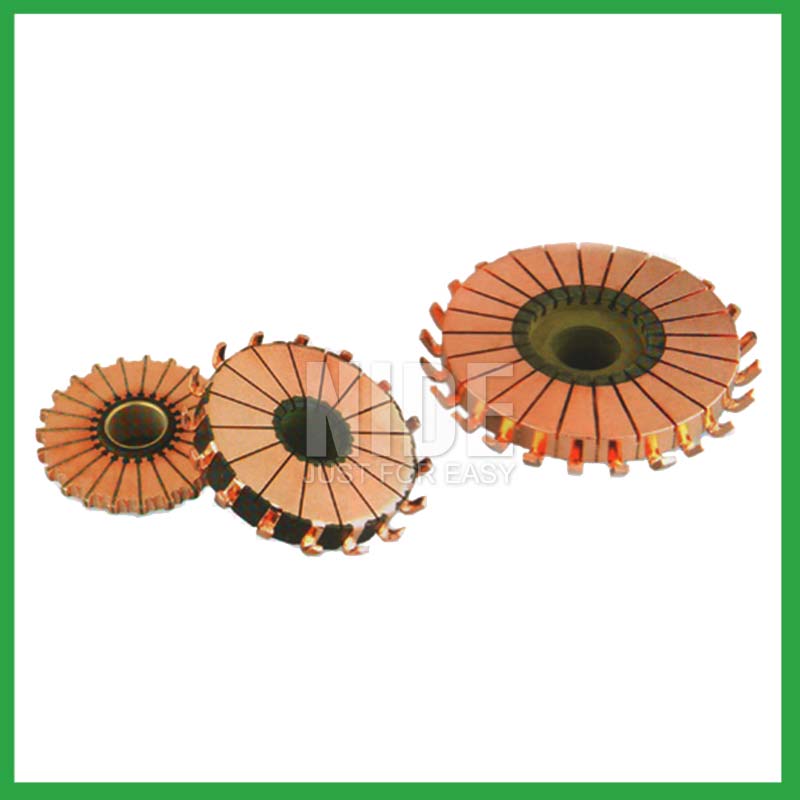PRODUCTS
CONTACT US
Ningbo Nide International Co., Ltd.
一一
· Contact person:Jack Zeng
· Mob/Whatspp/WeChat:0086-13738869026
· Email:emarketing@nide-group.com;marketing4@nide-group.com
· Add:No. 169, Wohushan Road, Daqi Subdistrict, Beilun District, Ningbo, China

Commutator brushes, often simply referred to as brushes, are critical components in electrical machines that use a commutator, such as direct current (DC) motors and generators. They play a key role in maintaining electrical contact between the rotating commutator and the stationary external circuit.
Tags: commutator brushes
Product Description:
NIDE Group is proud to offer the highest quality starter motor commutators, including armature rotor commutators. Our custom-made starter motor commutators are suitable for a variety of applications. With our experienced ODM (Original Design Manufacturer) team, we are able to produce the perfect starter motor commutators solutions that meet all your specific requirements. Our products are made with the highest grade materials to ensure top-notch performance and durability.
Technical Parameters:
|
Parameter |
Value |
|---|---|
|
Warranty |
4months-1year |
|
Size |
Customized |
|
Usage |
Spare Parts For Electric Motor |
|
Supplier |
NIDE Group |
|
Suitabel for |
Armature Rotor |
|
Package |
Carton/Wooden Box |
|
Material |
0.04% Or 0.08% Sliver Copper Commutator |
|
Customized |
YES |
|
OEM |
YES |
|
Piece |
5/ 7/ 1012/ 16/ 18/ 20/ 24/ 28/ 30/ 36 Bar |
Nide produces more than 1200 different types of motor commutator, including hook type, riser type, shell type, planar type, ranging from OD 4mm to OD 150mm and we are professional in manufacturing commutator for many years. The commutators are widely applied to automotive industry, power tools, household appliances, and other motors.If our existing models are not suitable for you, we could also develop new tooling according to your drawing and samples.
What are commutator brushes and their roles in DC motors and generators?
The commutator brush is an important component of motors that use commutators, such as DC motors and generators. Their main function is to promote current transmission between the rotating commutator and the fixed external circuit.
Commutator brush:
Commutator brushes are usually made of carbon or carbon composite materials. They are designed to make physical contact with the segments of the commutator, which is a rotating, segmented cylindrical component.
Function in DC motors:
Electrical contact: In a DC motor, the commutator brush maintains direct and continuous electrical contact with the commutator blade. When the armature (rotor) of the motor rotates, the brush slides on the commutator, ensuring that current can flow from the external circuit to the armature coil.
Current reversal: One of the key functions of the commutator brush is to reverse the current when the armature coil rotates. The commutator blades are insulated from each other, and the brushes establish connections with different commutator blades at different points of rotation. This reversal of current direction is crucial for the continuous rotation of the motor.
Role in DC generators:
Power generation: In a DC generator, the commutator brush helps to convert mechanical energy into electrical energy. When the armature rotates in a magnetic field, the brush maintains contact with the commutator blade, causing the generated current to flow from the armature to the external circuit.
Direction control: The commutator brush ensures that the generated current has a consistent direction. They come into contact and disconnect with different commutator blades to generate direct current (DC) output. This directional control is crucial for generating stable direct current.
Maintenance and precautions:
The material for electric brushes, usually carbon or carbon composite materials, is selected based on its durability, low friction, and conductivity.
Regular maintenance of commutator brushes is necessary as they may wear out over time and may need to be replaced.
The correct adjustment and alignment of the brush is crucial to ensure consistent electrical contact with the commutator.

